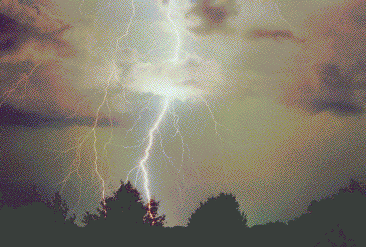Lightning is one of those phenomena of nature that isn't fully understood. It is caused by a separation of positive and negative ions within the thunderstorm cloud, or cumulonimbus. The uncertainty lies in just how the positive and negative ions become separated.
It is known that most of the typical cumulonimbus is at a temperature below freezing. The rest of this information is based largely on theory.
It is believed that the presence of ice or supercooled water droplets (unfrozen water droplets that are below 32 degrees Farenheight) play a role in the separation of charge. This separation is produced by turbulence within the cloud, usually in the presence of a strong updraft. Lighter, positive ions are believed to collect in the upper-reaches of the cloud, with heavier, negative ions collecting closer to the cloud base.
Since opposite charges attract, "electrical breakdown" of the air between these two oppositely-charged regions will occur, and cloud-to-cloud lightning is the result. When the discharge takes place between the negatively-charged cloud base and a positively-charged portion of the earth's surface, cloud-to-ground lightning is the result. This discharge is very similar to the discharge of static electricity from your finger to a doorknob.

Carl Morgan, 1995
To try to answer your question, cloud-to-ground lightning most likely can occur without the presence of hail, but the presence of hail, or at least super-cooled water, probably increases the likelihood of a strike. Also remember that hail is often present in the tops of the cumulonimbus, but commonly melts before it reaches the ground.
To further confuse the matter, lightning can occur in snowstorms, in sandstorms, in non-thunderstorm rain and ice, in the ejected material from volcanic eruptions, near fireballs created by nuclear explosions, and even "bolts from the blue" have been reported.
An excellent source of information on lightning is the book "All About Lightning", by Martin A. Uman. Much of this material was obtained from this source.